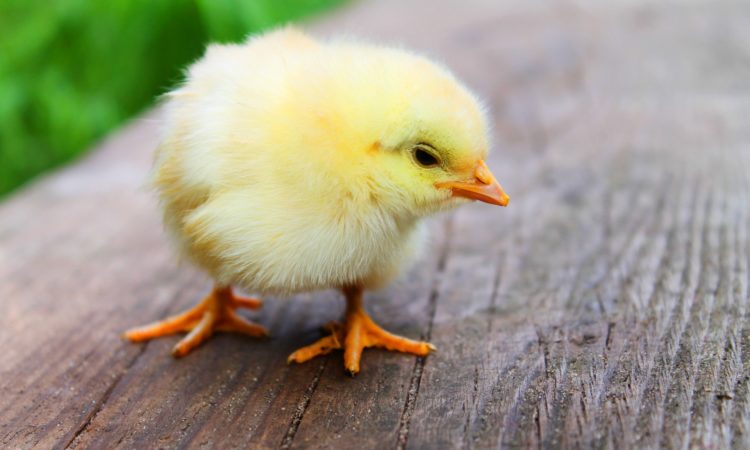How to Prepare Before Your Chicks Arrive
What do you need to have ready for these babies?
1) A secure box with tall sides
2) A heat lamp (any feed store or on Amazon)
3) A watering dish that’s made for chicks (any feed store or on Amazon)
4) A feeder that’s made for chicks (any feed store or on Amazon)
5) Chick crumbles (any feed store)
6) Paper towels
7) Netting to place over the top of the box for when – and it only takes couple of weeks – your babies get curious and have grown itty bitty wings that allow them to fly up to perch on the edge of it. If you want to keep them securely IN the box, you’ll need netting or some equivalent that’s breathable and lets in light but doesn’t let the chicks out.
Where should you set up for your chicks?
An unused bathroom or bedroom or mudroom or porch or garage would be a good place to set up your box. My first choice is my garage. Things will stay pretty clean at first, because you’re only using paper towels in the box, but at the point when you move to shavings (at about two weeks), things can get a little dusty!
Once you pick a spot, line the bottom of the box with paper towels. Paper towels are ideal to start, because chicks poop a lot, and you’ll want to keep things clean. For at least the first two weeks you can simply fold up the dirty paper towels, put them in the trash (wrapped in a plastic bag is a good idea, to avoid letting the smell go everywhere), and then replace with fresh ones.
Set the chick waterer and feeder in the box.
Now hang your heat lamp over the box from something very secure (we use a heavy coat rack). Then double secure the lamp. You don’t want it somehow dropping any lower than the height you’ve chosen or to – worst case – fall into the box. This could be death for the chicks and a potentially deadly fire in the household. When the chicks arrive you will adjust the height to make sure they’re not too warm and not too cold.
WHAT TO DO WHEN YOUR CHICKS ARRIVE HOME
Tiny peeping fluffballs!—what do you do first?
1) Dip each chick’s beak in water and make sure they have a sip. Whatever distance they’ve just traveled, you want to make sure they’re quickly hydrated.
2) Set them in the box. They should peep, toddle around, and discover the food and water dishes.
3) Sit and watch them for a while.
Is anyone having trouble finding the food and waterer? You may need to show them.
Do you need to lower or raise the heat lamp? If you see your chicks huddling right under the light, they’re too cold – you need to lower the light to give them a warmer environment. If they flee the light for a darker corner of the box, they are overheated. Raise the light to reduce the intensity of the heat. I also like to provide the chicks a big enough box/area to have half of the box covered by the heat lamp and the other half free of the heat lamp. This allows the chicks to freely find there comfort zone and you dont have to worry so much about their temperature. I also like to put my water in the not heated side so it stays cool enough for the chicks to drink comfortably.
IMPORTANT: Chicks in a heap in either a dark or very light place means your whole group of chicks is too hot or cold, and they’re all trying to compensate. With a couple of tries, you’ll find the “just right” spot, where everyone looks relaxed, and either mills around comfortably in the box or sprawls in sleep neither directly under the bulb or in a dark corner.
4) If you keep watching, you’ll see that after a period of activity they flop and fall over into little heaps, sound asleep. This may frighten you into thinking they’re dead, but no – they’re (usually) just sleeping.
Now you’ve got them safe in their box, with access to food and water, and in a comfortable “climate.” Hooray!
Give them a little time to adjust, and soon you’ll be getting to know each other.
FEATHERING OUT MEANS FLIGHT
If you’re new to chickens, you’ll be amazed – within a couple of days you’ll already begin to see the tiniest of feathers beginning to sprout. What this means is that they’ll soon have the capacity to fly, and actually be the best fliers they’ll ever be in their lifetimes.
For them, this means that perching on the edge of the top of their enclosure, cardboard box or other, is possible within as little as a week. (What fun to see what lies beyond the confines of The Box.) For you, this means potential Baby Birds on the Loose.
As mentioned above, it’s time to put some type of covering on their enclosure – something breathable that also lets the light in. Bird netting, for example, can work well for this.
INTRODUCING YOUR CHICKS INTO YOUR EXISTING FLOCK
If you have an existing flock integrating your new chicks in a safe way is very important as chickens can be very ruthless. I have integrated 3 rounds now of baby chicks successfully into my flock. When the new chicks are at least have the size of a full grown chicken you can safely start this process.
Important: Do not just throw your new half grown chicks into the coop and hope for the best, they are too small and will get picked on by the other chickens. Also make sure they are big enough with proper feather coverage so they are able to withstand the outdoor temperatures.
Three tips to successfully integrate your new chicks:
Step 1: Create a safe area where you can have your chicks live next to your chickens. I created a living area inside the chicken run, protected by chicken wire, with feed, water, and a dog igloo house. to allow my chicks and chicken flock to get used to the idea of one another without the threat of being pecked or a fight to break out.
Step 2: Give it enough time. I have waited sometimes up to a full month making sure both sides are very used to each other. Don’t rush the process, there is no risk into waiting a few more days or weeks. Once they are ready, remove the temporary housing the baby chicks were using.
Step 3: Monitor your chicks after integration. For at least a week, I recommend keeping a close eye of your chicks and seeing how they are integrating into the flock.
You may need to help your new chicks understand their coop and where to roost at night. At night after integration, I go out and do a quick check to see if the chicks made it in for the night. There have been several times where I have had to move a few chicks into the coop at night. No need to worry as they are pretty quick learners and started going in there on their own after a few nights of help.

